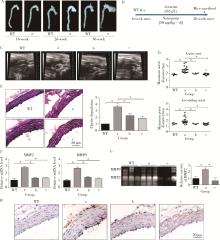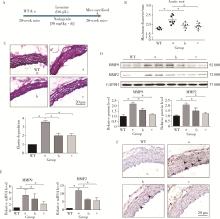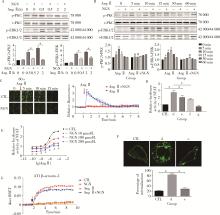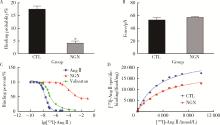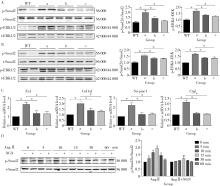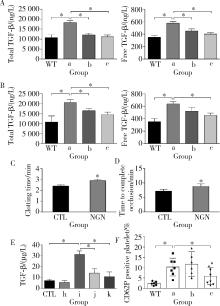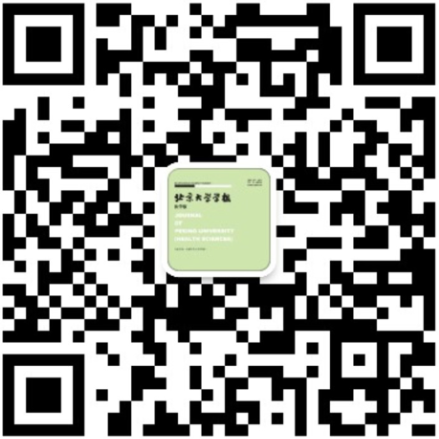北京大学学报(医学版) ›› 2022, Vol. 54 ›› Issue (5): 896-906. doi: 10.19723/j.issn.1671-167X.2022.05.017
柚皮素抑制马凡综合征小鼠胸主动脉瘤的形成
李芷晴1,俞冰1,蔡泽宇1,王迎宝1,张煦1,周彪2,方晓红3,于芳1,付毅1,孙金鹏1,李伟4,孔炜1,*( )
)
- 1. 北京大学基础医学院生理学与病理生理学系,北京 100191
2. 中日友好医院普外科,北京 100029
3. 中国科学院化学研究所,北京 100190
4. 北京大学人民医院血管外科,北京 100044
Naringenin inhibits thoracic aortic aneurysm formation in mice with Marfan syndrome
Zhi-qing LI1,Bing YU1,Ze-yu CAI1,Ying-bao WANG1,Xu ZHANG1,Biao ZHOU2,Xiao-hong FANG3,Fang YU1,Yi FU1,Jin-peng SUN1,Wei LI4,Wei KONG1,*( )
)
- 1. Department of Physiology and Pathophysiology, Peking University School of Basic Medical Sciences, Beijing 100191, China
2. Department of General Surgery, China-Japan Friendship Hospital, Beijing 100029, China
3. Institute of Chemistry, Chinese Academy of Sciences, Beijing 100190, China
4. Department of Vascular Surgery, Peking University People's Hospital, Beijing 100044, China
摘要:
目的: 探究柚皮素对马凡综合征胸主动脉瘤的作用。方法: 对马凡综合征模型Fbn1C1039G/+小鼠进行柚皮素灌胃,观察柚皮素对小鼠胸主动脉瘤形成的影响,并在体外利用生物荧光共振能量转移、原子力显微镜、同位素标记配体-受体结合等技术探究柚皮素发挥作用的分子机制。结果: Fbn1C1039G/+小鼠予以柚皮素长期预防性给药(6~26周)或治疗性给药(20~26周)均显著抑制小鼠胸主动脉瘤的扩张和弹力板的断裂。同时,柚皮素喂养可降低小鼠血管壁Smad2和细胞外调节蛋白激酶1/2(extracellular regulating kinase 1/2,ERK1/2)的磷酸化以及基质金属蛋白酶(matrix metalloproteinase, MMP)2/9的表达与活性。机制上,柚皮素处理降低血管紧张素Ⅱ(angiotensin Ⅱ,Ang Ⅱ)受体1(angiotensin Ⅱ type 1 receptor,AT1)下游Gq蛋白介导的蛋白激酶C(protein kinase C,PKC)和ERK1/2的磷酸化、钙离子信号和活化T细胞核因子(nuclear factor of activated T-cells, NFAT)信号,同时柚皮素可降低Ang Ⅱ引起的AT1受体内化及β-抑制蛋白-2与AT1受体的结合,并拮抗与AT1的配体-受体结合;柚皮素可以降低转化生长因子-β(transforming growth factor-β,TGF-β)信号通路下游基因的表达,并显著降低Fbn1C1039G/+小鼠血浆中过高的TGF-β水平。血小板是体内TGF-β的主要储存细胞,而柚皮素处理可以抑制凝血酶引起的血小板激活,减轻Fbn1C1039G/+小鼠的血小板活化程度,并降低血小板分泌TGF-β的水平。结论: 柚皮素可能通过抑制AT1受体信号及减少TGF-β产生从而抑制马凡综合征胸主动脉瘤的发生与发展。
中图分类号:
- R33
| 1 |
Milewicz DM , Braverman AC , De Backer J , et al. Marfan syndrome[J]. Nat Rev Dis Primers, 2021, 7 (1): 64.
doi: 10.1038/s41572-021-00298-7 |
| 2 |
Holm TM , Habashi JP , Doyle JJ , et al. Noncanonical TGFβ signaling contributes to aortic aneurysm progression in Marfan syndrome mice[J]. Science, 2011, 332 (6027): 358- 361.
doi: 10.1126/science.1192149 |
| 3 |
Habashi JP , Judge DP , Holm TM , et al. Losartan, an AT1 antagonist, prevents aortic aneurysm in a mouse model of Marfan syndrome[J]. Science, 2006, 312 (5770): 117- 121.
doi: 10.1126/science.1124287 |
| 4 |
Cook JR , Clayton NP , Carta L , et al. Dimorphic effects of transforming growth factor-beta signaling during aortic aneurysm progression in mice suggest a combinatorial therapy for Marfan syndrome[J]. Arterioscler Thromb Vasc Biol, 2015, 35 (4): 911- 917.
doi: 10.1161/ATVBAHA.114.305150 |
| 5 |
Jia Y , Zhang L , Liu Z , et al. Targeting macrophage TFEB-14-3-3 epsilon Interface by naringenin inhibits abdominal aortic aneurysm[J]. Cell Discov, 2022, 8 (1): 21.
doi: 10.1038/s41421-021-00363-1 |
| 6 |
Rodríguez-Vita J , Sánchez-López E , Esteban V , et al. Angiotensin Ⅱ activates the Smad pathway in vascular smooth muscle cells by a transforming growth factor-beta-independent mechanism[J]. Circulation, 2005, 111 (19): 2509- 2517.
doi: 10.1161/01.CIR.0000165133.84978.E2 |
| 7 |
Touat Z , Lepage L , Ollivier V , et al. Dilation-dependent activation of platelets and prothrombin in human thoracic ascending aortic aneurysm[J]. Arterioscler Thromb Vasc Biol, 2008, 28 (5): 940- 946.
doi: 10.1161/ATVBAHA.107.158576 |
| 8 |
Metelli A , Salem M , Wallace CH , et al. Immunoregulatory functions and the therapeutic implications of GARP-TGF-β in inflammation and cancer[J]. J Hematol Oncol, 2018, 11 (1): 24.
doi: 10.1186/s13045-018-0570-z |
| 9 |
Fusi F , Trezza A , Tramaglino M , et al. The beneficial health effects of flavonoids on the cardiovascular system: Focus on K(+) channels[J]. Pharmacol Res, 2020, 152, 104625.
doi: 10.1016/j.phrs.2019.104625 |
| 10 |
Burke AC , Sutherland BG , Telford DE , et al. Naringenin enhances the regression of atherosclerosis induced by a chow diet in Ldlr (-/-) mice[J]. Atherosclerosis, 2019, 286, 60- 70.
doi: 10.1016/j.atherosclerosis.2019.05.009 |
| 11 |
Wisler JW , Harris EM , Raisch M , et al. The role of beta-arrestin2-dependent signaling in thoracic aortic aneurysm formation in a murine model of Marfan syndrome[J]. Am J Physiol Heart Circ Physiol, 2015, 309 (9): H1516- 1527.
doi: 10.1152/ajpheart.00291.2015 |
| 12 |
Teixido-Tura G , Forteza A , Rodríguez-Palomares J , et al. Losartan versus atenolol for prevention of aortic dilation in patients with marfan syndrome[J]. J Am Coll Cardiol, 2018, 72 (14): 1613- 1618.
doi: 10.1016/j.jacc.2018.07.052 |
| 13 |
van Andel MM , Indrakusuma R , Jalalzadeh H , et al. Long-term clinical outcomes of losartan in patients with Marfan syndrome: follow-up of the multicentre randomized controlled COMPARE trial[J]. Eur Heart J, 2020, 41 (43): 4181- 4187.
doi: 10.1093/eurheartj/ehaa377 |
| 14 |
Rifkin DB , Rifkin WJ , Zilberberg L . LTBPs in biology and medicine: LTBP diseases[J]. Matrix Biol, 2018, 71/72, 90- 99.
doi: 10.1016/j.matbio.2017.11.014 |
| 15 |
Li W , Li Q , Jiao Y , et al. Tgfbr2 disruption in postnatal smooth muscle impairs aortic wall homeostasis[J]. J Clin Invest, 2014, 124 (2): 755- 767.
doi: 10.1172/JCI69942 |
| 16 |
Wei H , Hu JH , Angelov SN , et al. Aortopathy in a mouse model of marfan syndrome is not mediated by altered transforming growth factor beta signaling[J]. J Am Heart Assoc, 2017, 6 (1): e004968.
doi: 10.1161/JAHA.116.004968 |
| 17 |
Hernandez-Aquino E , Zarco N , Casas-Grajales S , et al. Naringenin prevents experimental liver fibrosis by blocking TGFbeta-Smad3 and JNK-Smad3 pathways[J]. World J Gastroenterol, 2017, 23 (24): 4354- 4368.
doi: 10.3748/wjg.v23.i24.4354 |
| 18 |
Lim W , Song G . Naringenin-induced migration of embrynoic trophectoderm cells is mediated via PI3K/AKT and ERK1/2 MAPK signaling cascades[J]. Mol Cell Endocrinol, 2016, 428, 28- 37.
doi: 10.1016/j.mce.2016.03.018 |
| 19 |
Yang Y , Xu Y , Xia T , et al. A single-molecule study of the inhibition effect of Naringenin on transforming growth factor-beta ligand-receptor binding[J]. Chem Commun (Camb), 2011, 47 (19): 5440- 5442.
doi: 10.1039/C1CC10778J |
| 20 |
Lopez JJ , El Haouari M , Jardin I , et al. Flavonoids and platelet-derived thrombotic disorders[J]. Curr Med Chem, 2019, 26 (39): 7035- 7047.
doi: 10.2174/0929867325666180417170218 |
| [1] | 邓佳慧,黄筱琳,刘晓星,孙杰,陆林. 中国睡眠医学的过去、现在和未来[J]. 北京大学学报(医学版), 2023, 55(3): 567-封三. |
| [2] | 霍阳,周兵,何红彦,赵龙,张雪丽,李静,左玉花,郑宇,任正洪,韩芳,张俊. 腕表式睡眠监测仪与多导睡眠监测的睡眠参数比较和相关性分析[J]. 北京大学学报(医学版), 2021, 53(5): 942-945. |
| [3] | 任茜,周建,王鸣刚,陈克明. 脉冲电磁场促进成骨细胞成熟分化依赖于初级纤毛-PI3K/AKT途径[J]. 北京大学学报(医学版), 2019, 51(2): 245-251. |
| [4] | 李满,李圆,孙麟,宋君来,吕聪. 高迁移率族蛋白B1通过调节Bcl-2和Bax蛋白表达促进氧糖剥夺/复氧星形胶质细胞的凋亡[J]. 北京大学学报(医学版), 2018, 50(5): 785-791. |
| [5] | 冯永良,范静慧,林宪娟,杨吉春,崔庆华,汤新景,徐国恒,耿彬. 荧光探针包被法测定血浆硫化氢浓度[J]. 北京大学学报(医学版), 2017, 49(6): 1060-1065. |
| [6] | 张晓威,兰轲,杨文博,李清,赵永平,殷华奇,Kite Brandes,白文俊,徐涛. 跨膜蛋白CMTM2在人睾丸和精子中的表达及定位[J]. 北京大学学报(医学版), 2017, 49(4): 575-579. |
| [7] | 王玉洁,郭向阳,王军. 重复异丙酚麻醉对新生大鼠海马细胞凋亡及远期学习记忆能力的影响[J]. 北京大学学报(医学版), 2017, 49(2): 310-314. |
| [8] | 肖洋,杜瑶瑶,高成,孔炜. microRNA在高磷诱导血管平滑肌细胞钙化早期的动态变化[J]. 北京大学学报(医学版), 2016, 48(5): 756-765. |
| [9] | 王起,胡浩,梁晨,王佳,许克新. 轮值夜班对女性护士排尿的影响[J]. 北京大学学报(医学版), 2016, 48(4): 659-662. |
| [10] | 王莺, Obada Barry, Gerhard Wahl, 陈波,林野. 应用激光多普勒血流仪监测口腔黏膜血流[J]. 北京大学学报(医学版), 2016, 48(4): 697-701. |
| [11] | 秦雪嫣,赵华翔,张倩,陈峰,林久祥. NELL-1: 高效特异的新型生长因子[J]. 北京大学学报(医学版), 2016, 48(2): 380-383. |
| [12] | 杨广聚, 曹烨, 张磊, 秦雪英, 谢秋菲. 健康人口的颌面部定量躯体感觉功能数据及其影响因素分析[J]. 北京大学学报(医学版), 2015, 47(3): 521-528. |
| [13] | 郑扬, 李危石, 刘忠军. 骨组织3D打印:骨再生的未来[J]. 北京大学学报(医学版), 2015, 47(2): 203-206. |
|
||
